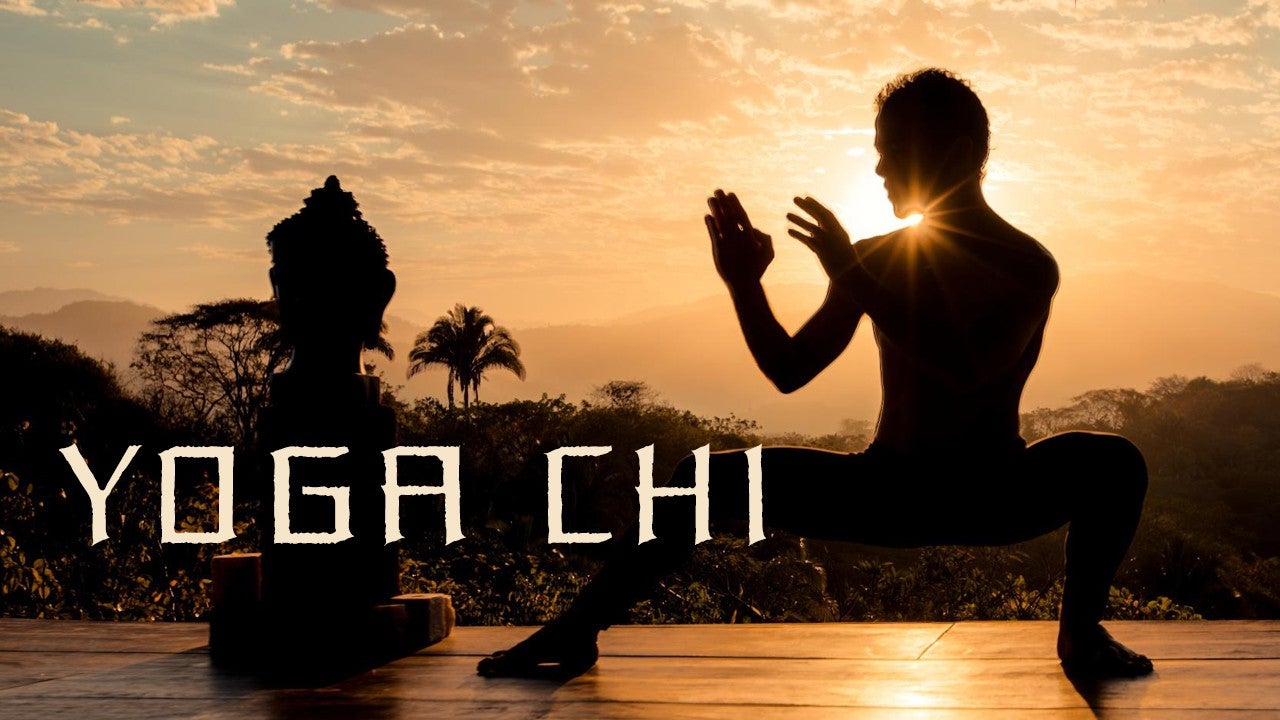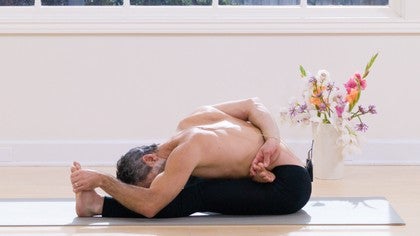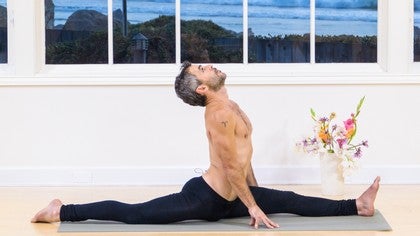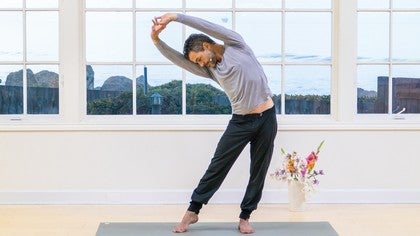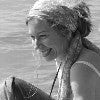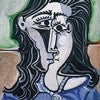Description
About This Video
Transcript
Read Full Transcript
Welcome. In this episode I'm going to share with you the art of qigong. Qigong is a form of yoga that originated in China and the term qi means energy and gong means cultivation. Qi is equivalent to prana and basically it refers to the electromagnetic currents energy that runs through the body. So I hope you enjoy this practice. Let's begin by bringing our legs straight out. Reach through your heels comfortably, adjust your sit bones and then starting with the right leg. Take the right leg up and place the right ankle, outer ankle, right on the left upper thigh bone. Take a good hold of the foot and begin to circle the ankle about 10 times and reverse. From here after you've circled the ankle both directions you're going to begin to do a little self massage in the lower leg and you begin down near the Achilles tendon with the thumbs. Get both thumbs in there and apply a little pressure squeeze and release. Squeeze and release. Squeeze and release and just work up the back of the calf, right up the belly of the calf and then making your way back down. Squeeze and release. From here you're going to take your right foot you're going to place the right foot flat, interlace your fingers and do a little self massage with the heel of the palm the upper shin bone. In Chinese medicine these are some of the most important points for boosting the immune system. You can undo the fingers and you can work a little further down the shin bone, inner and outer and then one more time you're going to take your thumbs to the back of your calf, start at the top of the calf and apply a little pressure release. Pressure release. When you get down to the ankle do a light little brush of the lower leg. Before we switch sides take the leg and just cradle it easily. Check in with the hip, knee and the ankle and release. Adjust your sit bones if needed and then we'll switch taking the left outer ankle to the thigh bone, take a good hold of your foot and then begin again to circle the ankle joint ten times. Qigong is a wonderful practice for helping circulate the blood and the lymph. Due to gravity lymph likes to settle and that's why I like to start with the lower leg. The lymph doesn't have an organ to pump it, the heart pumps the blood so things that help circulate the lymphatic system reverse if you haven't reversed. Things that help circulate the lymph system are massage, movement, deep breathing. Once you've circled in both directions at least ten times we're going to do a little self massage again and start down near the Achilles tendon with both thumbs apply a little pressure squeeze and release, squeeze and release and work up the calf. In Chinese medicine this inner leg line is some of the most important points. Along this inner leg line run the liver channel, spleen pancreas and the kidney channel. The back of the calf is the urinary bladder channel and these are some of the most important points. They're not just for the urinary bladder but they're some of the most important points for helping relieve back pain. The ankle is for the neck, the mid calf is for the mid back and the back of the knees for the lower back. Once you've massaged that lower leg you're going to place your foot flat, you're going to interlace your fingers and with the heel of the palms again massage the upper shin. Now this point I just want to touch on this just briefly this is one of the most powerful points in Chinese medicine it's known as stomach 36 it lies about four fingers below the patella the base of the knee on the outer shin and this point has a name and it's called the three-mile point and the story is when the Chinese used to march their soldiers 24 miles at the end of the day they'd have to sit down and massage this point for 10 minutes and they'd get an extra three miles out of them so basically it's designed to help rejuvenate the body and it's very powerful very powerful point that they're using with everyone from cancer patients all the way to Olympic athletes. After you've massaged the leg, shin bone you're gonna go to the back of the calf one more time with the thumbs apply pressure release apply pressure release and just work down the back of the calf and then do a light little brush and then checking in with the hip knee and ankle and cradle the leg gently and just very gently pull the left foot in and release. From here we're going to go into a real gentle passive forward bend normally I don't start the practice with forward bends because ideally you want to warm up the body this is passive the toes are pointing I'm not reaching through the heels here I'm not contracting the hamstrings from here I'm pointing the toes it's very very passive sliding the hands down they might get to the knees they might get to the shins they may get to the ankles this is more about drawing our attention inward and just take a breath or two here begin to take your attention down into the lower abdomen and deep slow inhale exhale fully and as you come up rise up sweep your feet behind you we're gonna tuck the toes opening up the arches and the toes knees can be at least hip width apart if you have knee issues and this doesn't feel comfortable in the knees keep the hands on the floor if you want to take it a stage further you can sit to the heels and if you want to go one stage further interlace the fingers and take the arms overhead palms overhead inhale relax the frontal ribs inhale and on the exhale slowly bring the hands down and we're gonna take all ten fingertips to the floor and apply a little pressure with the fingers wake up the pads of the fingers this promotes blood flow to the peripheral the periphery and then heels lift land easy forward bend knees slightly bent from this easy forward fold put a nice bend in the knees slide the hands to the thighs and slowly roll up slowly roll up and then once you're standing the feet are gonna step out hip width apart they're parallel before we continue with the warm-ups I want to set one thing up that's very fundamental to qigong the tongue is lightly touching the upper palate it's a very light connection the root of your tongue is relaxed and this helps up set up a channel that runs from the base of the spine up to the top of the head and back down to the base of the spine it also prevents the head from overheating it's a very fundamental principle in qigong and also in yoga so as we continue with our warm-ups tongue to the upper palate lips are gently sealed inhale arms come out and up this is called gathering chi it's a very classical move the tips of the middle fingers touch as you exhale the hands come down the center line slowly exhale exhale exhale the movement is very light coordinated with the breath inhale out and up relax the shoulders tips of the middle fingers touch slowly exhale exhale exhale one more time gathering chi inhale inhale slowly on the exhale compress down the center line this is a very grounding movement helps to calm the nervous system now as you complete that last round do a little shake of the arms we're gonna make a gentle fist all you do is you take the four fingers into the palm the thumb goes to the inside of the index finger and we're gonna start to tap the body and you're gonna begin by tapping right at the lower abdomen and sacrum the idea is just to kind of loosen up relax your shoulders all we're doing is simply hinging at the elbows and you're lightly tapping the torso once you get a little rhythm happening you're gonna start to work up the torso so from the lower abdomen we go to the midsection the backhand can move up into the kidneys this is starting to wake up the organs and gets blood flowing lymph and then working up into the chest lung points if you ever tap and you have any sensitive points you can always lighten the tap or just work around that area working back down midsection midsection and finishing where we started lower abdomen sacrum complete that light tap and as you complete the tap we're gonna take your right hand you're gonna put a little bend in the knees slight tuck of your tailbone and we're gonna continue this tapping sequence this is basically a meridian tapping sequence where we're tapping through some major acupressure points and channels and you start at the lower abdomen in Chinese medicine they call this point in this area the lower Dantian which means field of elixir and the yoga system we call this the Kanda which means bulbous root after you tap the center at least 10 20 times you're gonna slowly work up the solar plexus as you do so straighten your legs to a comfortable point watch that you're not hyper extending the knees you just straighten the legs so you stay balanced on the feet and then we work up to the heart center this is known as the middle Dantian you spend a little time here therapeutically we're tapping right over the thymus gland immune boosting gland you go a little higher and then you're gonna start to tap right through your left lung points as you tap through the left lung points you're gonna go under the arm up into the underarm this is the second largest lymph center of the body and after you spend a little time under the arm you're gonna relax that left arm and you're gonna drop underneath your left chest tapping over the stomach spleen and pancreas as you make your way back to the midline you're gonna go back up through the heart space so basically we're just circling the chest the left chest which has a lot of lymphatic tissue and as you go through the left lung points instead of going under the arm this time you're gonna continue down the inside of the arm until you meet the palm and after you tap the palm a few times you're gonna open up your right hand and you're gonna pat with an open hand up the outer arm lightly to the shoulder to the neck and then slide your right hand down the left arm and do a little self massage and shake it out now we do the other side make a little fist with the left hand put a little bend in the knees slight tuck of your tailbone so you meet that tap with some inner firmness at your core tap at least 10 times as you slowly start to work up the solar plexus the legs straight and comfortably and then you spend a little time at the heart space go a little higher through your right lung points under the right arm and then as you drop underneath the right chest let that right arm relax now we're right over the liver gallbladder the liver is one of the largest organs in the body so don't just tap in one place work it around a little bit and then as you get back to the center line and go back up through the heart space breast bone through the left lung right lung points and down the inside of the right arm open your left hand and with an open hand pat up the outer arm lightly to the neck and then slide your left hand down again do a little self massage and shake it now with open hands with the intersection of the hand we're just gonna start by tapping the waist and then moving from the waist to the lower back and then from the lower back go a little higher up into the kidneys and then back to the waist one more time lower back kidneys and waist and then the last section of the legs so you're gonna go back to the fist and you're gonna tap the groin this is the largest limp center of the body is the groin major transfer point in the body tap these ten times and then from the groin we're gonna work into the glutes and you go to the glutes and then slowly we're gonna start to go down the outer leg lines known as the yang lines in Chinese medicine you go down when you get just above your outer ankles go to the inside of the leg inner ankle and work up the inner leg line these are yin channels go through the inner thigh line and we're gonna work the inner thigh line from the knees back to the groin two more times working up one more and back to the glutes and then back to the front so tapping this inner leg line is actually very therapeutic for the heart how does this help the heart the saphenous vein that runs through the inner leg line it brings deoxy deoxygenated blood back to the heart from down below so when you keep this inner thigh line open it helps to bring blood flow back to the heart so it's something you can do for high blood pressure and it's um it's also good for bringing circulation to the lower abdomen reproductive organs so that's the tap down it's a real nice way to wake up the body from here what we're gonna do is we're gonna do continue with our our warm-ups and we're gonna do a little circling of the ankles again from a standing position I showed you how to do it from a seated position you can also do it from a standing position in this position all you're gonna do is you're gonna reach back with your left foot so I'll give you the side view like so and you're just gonna circle outward eight times this is good for the ankle and the idea is actually you want the entire leg to loosen up all the way up to the hip it's about eight and then you go inward you go one two three four five six seven eight and then you switch reach back with the other foot top of the foot gets a nice stretch you go outward one two shoulders relax three five six seven eight and then you reverse inward one two three four five six seven and eight find the balance between your feet take your thumbs just cross your thumbs cross one hand over the other and then again tongue to the upper palate drop your chin in we're gonna continue with the circles we're gonna start it up at the neck drop the chin in and very gently you're gonna circle your head eight times one and arrange a motion that feels right for you two three four five six seven and eight and then you reverse it other way one two three four five six seven and eight as you complete that last circle chin in towards the throat release the hands head level and then we go into the shoulders you're gonna go forward up back and down eight times one two three four five six seven eight reverse that back up forward down one two three four five six seven and eight now moving into the arms shoulders elbows and wrists you're gonna interlace your fingers stretch down and then bending at the elbows stretch up palms away now you're gonna shift your elbows are gonna bend you're gonna shift into your left leg left hip as you do so we're gonna start to bend off to the right you can lift the right heel if you have the balance and you're gonna stretch out to the right look down to the right foot and then as you come out of this you're gonna land the right heel bend the elbows shift into your right leg lift the left heel stretch out to the left look down coming back to center find the balance between both feet and reach straight up inhale now keep the fingers interlaced palms together hands about heart throat level and you're gonna circle the wrist and then reverse it's a little brain balancer circling movements are wonderful for lubricating the joints it helps helps to flush the joint with synovial fluid so it's a wonderful way to open up the body and to begin a practice palms together pull into the heart inhale and then exhale release the hands now we're gonna do one more for the wrist open up the points in the hands is very important in the qigong you're gonna take the hands out palms up it's a nice movement you're gonna pull in leading with the pinky and you pull in to the waistline it's called holding the egg you inhale you pull in and you get a nice stretch on the top of your wrists inhale and you got about the shape of an egg in the palm and then on the exhale you're gonna release the hands out palms face down exhale gentle spreading of the fingers exhale we're gonna do this two more times palms up with the breath you inhale you pull in to the waist inhale and then on the exhale focus on the palms exhale palms up one more time inhale pull in and then on the exhale release palms down so we're going down the ladder hips circle the hips so we're moving from the hips but this is also good for balance so as you're circling the hips pay attention to the soles of your feet you want to feel the weight transfer through all four corners of the feet heel heel ball of the foot ball of the foot it's about eight and then you go the other way heel heel ball of the foot ball of the foot you start to wake up those points in the soles of the feet moving from your center and eight and then you're gonna step the feet close together last one is for the knees hands on the thighs or the knees shoulders relaxed and then we circle the knees eight times just drop into a depth that feels right for you eight other way one two three four five six seven and eight straighten your legs take your feet out about hip width apart last little warm-up before we meet our first qigong form you're gonna rub the palms together get some warmth and then cover the eyes without blocking the nose relax all your facial muscles take a deep inhale and as you exhale slide the fingers from the forehead to the temples take the thumbs top of the jawline just in front of the earlobes apply a little pressure release slide down about an inch apply pressure release gently massage the jawline to the chin and then from the chin to a light little brush of the throat heart and abdomen so that's the warm-ups now we'll enter a qigong form moving from the warm-ups I'm going to show a qigong form where the feet are going to be all the way together in most qigong forms you'll find that you're in a slight squat feet or hip width but I want to share this one because this is a very classical yoga stance known as tadasana or samastiti now feet together heels together if your ankles are collapsing just do a little lift of the arch just to activate the ankles once you feel balanced in the feet you're gonna take your hands out about hip level and the fingers are gently spread you're not too hard with it you're not too soft it's a feeling like you're inflating the hands it's balloon like it's definitely on the softer side though so hands are hip level tongue to the upper palate and this movement the first movement is real simple on the inhale you're gonna be reaching out inhaling and the hands stay on this plane they're horizontal and exhale just very gently pull back traditionally the eyes get involved as you inhale the eyes open it's a soft gaze and as you pull back the eyes close exhale do a few more inhale open the eyes the opening and closing of the eyes is designed to they say dilate the liver meridian the liver is related to the eyes we do this a couple times inhale eyes open reaching gently sensing with the hands exhale close the eyes pull back exhale fully as you complete that last move allow the arms to completely release from the shoulders down to the fingertips and allow the eyes to open now as we move into the next stage it feels as if not just the hands are inflating but the entire arms are inflating in the first inhale the arms are gonna float up very gently at least a foot or so off the body inhale and then on the exhale arms relax will settle very slightly they feel like they're breathing inhale they're gonna go up a little higher and then exhale relax takes about three breaths to get to the next stage go a little higher inhale open up the palms the pads of your fingers gently exhale turning the hands inward you're gonna reach out like you're gathering energy inhale gather some chi and then as you exhale you bend at the elbows and you turn the palms in towards the navel and we're gonna hold this for at least five to eight breaths these poses these static poses can be held for longer durations this first one the arms are hip width and the hands are hip level elbows slightly out if your underarms are closing you want to create some opening under the underarms but be conscious that you're not lifting the traps you don't want to trap the traps you want to keep the shoulders relaxed tongue to the palate head in line with the spine as you hold this eyes can be closed or you can have a soft gaze as you breathe in the beginning the main focal point is the lower abdomen the lower Dantian over time classical teaching in Qigong is that we should they say that we should breathe down to the soles of the feet so it should feel as if you're breathing all the way down to the soles of the feet and actually all the way into the arms into the palms a couple more breaths here inhale and exhale as you complete that last exhale we're going to transition into the next stage very gently the palms turn up elbows pull in and then the arms are going to come out you inhale you reach out your palms turn down and back and as you exhale you're gonna reach all the way back inhale you're gonna pull your hands into your kidneys you inhale you pull into the kidneys hold the in breath in slide the hands around you're gonna come out about heart level outer edges of the hands touch like you're making an offering from the heart exhale very gently from the heart space and take the arms out exhale next move is called parting the sea inhale inhale exhale palms down from the crane style Qigong this is called closing the wings elbows bend wrists relax you inhale pull in spreading the wings exhale take the arms out bend at the wrists reach through your elbow joints relax your shoulders now it's important that the hands are slightly in front of your shoulders you don't want to have the hands pressing the walls away this tends to close the shoulder blades up and they say in Chinese medicine that the shoulder blades represent the wings of the heart and we want to keep the wings open so there's space between the shoulder blades they're not pinching together so having the hand slightly in front of the shoulders will prevent that you bend at the wrists and then again we're holding for at least five to eight breaths deep inhale complete exhale tongue to the palate soft gaze again if it's held for longer periods the eyes can close basically these are standing meditations and all these positions can be held for for several minutes transitioning to stage three the elbows sink a little bit the palms turn up relax your shoulders let the hands settle just enough so the shoulders relax and then again one more time very gently open up the hands this next move is called lifting the Chi inhale the hands come up and overhead you inhale you inhale and actually and then as you exhale the palms turn towards the brain towards the head elbows slightly forward so you can relax your shoulders and then this is the third form again holding slow the breath down let's take one more inhale exhale allow the tips of the middle fingers to slowly gravitate to one another when they meet take a deep inhale keep the connection between the middle fingers and slowly scan down the front of the upper body get as close as you can without touching exhale slowly down head throat heart lungs abdomen as the hands release from one another the arms are gonna come up the wrists are relaxed feel as if as if you're being drawn up from the tops of your wrists you inhale it's very light when you get almost all the way to the top bend at the elbows and again exhale touch the tips of the middle fingers when they meet take a deep inhale and again you're gonna compress down and just before you touch the top of the head you're gonna separate the tips of the middle fingers and you're gonna scan past your ears exhale all the way down exhale exhale exhale the hands are gonna land shoulder level palms face forward and then with your left hand you're gonna inhale you're gonna pull back it's called catching the chi you pull back just enough and on the exhale very slowly extend that left arm out completely as the left arm completely extends straighten through your wrist turn your palm to the right and then it's called scooping the chi it's like you're catching some energy you turn from the waist you inhale you seal the left fingers very gently and as you pull that left hand back in it's gonna go to your upper right lung points just underneath the collarbone you're gonna sink your left elbow exhale shoulders are square back to the front then you catch the chi with the right hand you pull back you inhale and then as you exhale send the right arm out very gently palm turns to the left and then scooping the chi turn from the waist inhale pull the right hand in cross the arms very gently at the heart space now the right hand is touching the left lung points the arms are relaxed shoulders relaxed I want you to take your three deepest breaths of the practice packing the chi packing the breath it doesn't mean you need to suck the breath in it's more of a seeping is allow it to flow into the body and imagine that the breath is going beyond the lungs take one more inhale exhale fully eyes open if they're closed the last part of the sequence the wrist stay connected you take the hands off the chest you bring your inner wrist together in this last section it's called lotus palm the inner wrist stay together you open up the hands gently gentle extension into each fingertip three breaths inhale as you exhale the palms meet and you pull the hands into the heart and that completes the sequence release the hands down I just want to touch on just a few aspects the hands opening up the hands you'll find that in this practice the hands will actually get really blotchy and that's a good sign it's a sign that the capillaries are opening up and in Chinese medicine they say when the blood moves the chi moves and the blood moves the chi moves so you want the energy to transfer all the way out to the hands when we're turning the hands towards a particular body part like the navel or sending energy towards that area this is more of a clearing action this clears the chest and the lungs and the heart this is more sending energy to the brain I want to conclude this practice by showing the most important qigong stance many different styles of qigong at the heart of all qigong is a particular stance known as horse stance where the feet are slightly wider than the hips the knees are bent there's a little extra weight on the outer edges of the feet and you can see the the legs are kind of like a horseshoe there's a slight slight tuck of the tailbone so you go into a little squat and then the hands come from the heart I actually like to start with the legs straight you reach out from the heart space you open up the scapula the palms separate slowly and then slowly allow the hands to separate from one another and then the knees bend as the elbows sink just a little below the wrists and you gaze to the hands again if it's held for longer periods you can close the eyes there's a slight tuck of the tailbone very slight breathing deeply down into the lower abdomen so this can be held for long periods traditionally in qigong this is held for up to 20 30 minutes sometimes even an hour qigong is very therapeutic for the bones the main focal point in qigong is the bones and it's less on the muscles they say the outer body should be soft the inner body is firm and that firmness represents the bones when the bones have a nice vibration running through them it has a direct effect on our blood within our bones is our bone marrow so therapeutically qigong is very very wonderful for helping with certain healing crises in particular cancer patients really benefit from this practice but again this is a practice that can be also anyone can practice it top elite athletes practice qigong because it helps to condition the inner body the bones and the tendons within your bones I'll just say this one more time just to emphasize the importance of the bones within the bones it's where red blood cells white blood cells platelets lymphocytes are born within the marrow so again when the marrow is strong the blood is strong and the immune system is strong so I invite you to experiment with this practice check it out horse stance is a wonderful practice there's many different arm variations the arms are just like antennas again this is the fundamental one and the the thing I'd love to share with you is this is actually an incredible heart opener when the hands face the heart they're actually sending energy to the heart and it's a it's a it's a wonderful way to kind of work with this center too it's a very meditative practice very therapeutic practice so I hope you enjoy this including feet together
Yoga Chi
Comments
Isn't he wonderful and great idea! xokira
You need to be a subscriber to post a comment.
Please Log In or Create an Account to start your free trial.
